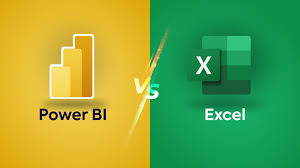Read more
Power BI vs. Excel: Which is Better for Data Analysis?
In today’s data-driven world, the right tools can significantly impact how effectively you analyze and present data. Power BI and Excel are two of the most popular tools, but they cater to different needs and use cases. In this blog, we’ll explore their capabilities, key differences, and when to use each, helping you make an informed choice.
What is Power BI?
Power BI is a business intelligence tool developed by Microsoft for interactive d
ta visualization and analysis. It allows users to connect to multiple data sources, transform data, and create real-time dashboards and reports. Designed for professionals who need advanced analytics, Power BI is ideal for handling large datasets and producing dynamic, shareable insights.
Key Features of Power BI:
- Interactive and real-time dashboards
- Advanced data modeling
- Seamless integration with Microsoft tools like Azure, Dynamics 365, and Teams
- AI-powered analytics and natural language querying
- Cloud-based collaboration and sharing
What is Excel?
Excel is a versatile spreadsheet application that has been a staple for data analysis since its release. Known for its simplicity and broad adoption, it’s used for everything from budgeting and forecasting to basic data visualization and statistical analysis.
Key Features of Excel:
- Grid-based data entry and formula-driven calculations
- Pivot tables for summarizing and analyzing data
- Basic charting and visualization options
- Macros for automating repetitive tasks
- Compatibility with a wide range of file types
Power BI vs. Excel: Main Differences
| Feature | Excel | Power BI |
|---|---|---|
| Purpose | Spreadsheet and basic data analysis | Advanced business intelligence and analytics |
| Data Volume | Limited to 1M rows | Handles massive datasets with ease |
| Visualization | Basic charts and graphs | Advanced, interactive dashboards |
| Real-Time Data | Requires manual updates | Automated and real-time data updates |
| Collaboration | Limited sharing with version control issues | Seamless, cloud-based collaboration |
| AI Features | None | Predictive analytics, natural language queries |
| Learning Curve | Easy for beginners | Moderate, but intuitive for advanced user |
Power BI vs. Excel – Finding the Better Data Analysis Tool
1. Data Volume and Complexity
- Excel is suitable for small to medium-sized datasets but struggles with performance when handling millions of rows or complex calculations.
- Power BI can process and visualize large datasets efficiently, thanks to its data compression technology.
2. Visualizations and Dashboards
- Excel provides basic charts and graphs but lacks the interactive capabilities that modern businesses require.
- Power BI delivers sleek, interactive dashboards that update in real time, making it a superior choice for presenting insights.
3. Automation
- In Excel, automation requires VBA macros, which can be complex to implement and maintain.
- Power BI automates data refreshes and integrates seamlessly with data sources for continuous updates.
4. Accessibility and Collaboration
- Excel works best for standalone use or small team collaborations but struggles with version control in shared environments.
- Power BI’s cloud-based nature makes it a winner for team-based projects, as multiple users can collaborate on the same dashboard or report.
Power BI vs. Excel: When Should You Use Each?
When to Use Excel:
- You need a quick and simple solution for data entry or small-scale analysis.
- The project involves calculations, basic summaries, and non-interactive charts.
- You’re working alone or with a small team and don’t require cloud-based collaboration.
When to Use Power BI:
- You need to analyze and visualize large, complex datasets.
- Real-time updates and interactive dashboards are essential for decision-making.
- Your organization relies on collaboration across teams and needs advanced business intelligence.
- You require predictive analytics and AI-powered insights.
Conclusion
Excel remains a versatile and reliable tool for basic data analysis and calculations, but Power BI is the future of business intelligence. With its advanced capabilities for handling large datasets, creating dynamic visualizations, and enabling real-time collaboration, Power BI is an indispensable tool for professionals aiming to turn data into actionable insights.
Job Interview Preparation (Soft Skills Questions & Answers)
Tough Open-Ended Job Interview QuestionsWhat to Wear for Best Job Interview Attire
Job Interview Question- What are You Passionate About?
How to Prepare for a Job Promotion Interview
Stay connected even when you’re apart
oin our WhatsApp Channel – Get discount offers
500+ Free Certification Exam Practice Question and Answers
Your FREE eLearning Courses (Click Here)
Internships, Freelance and Full-Time Work opportunities
Join Internships and Referral Program (click for details)
Work as Freelancer or Full-Time Employee (click for details)
Flexible Class Options
Week End Classes For Professionals SAT | SUNCorporate Group Training Available
Power Bi Advanced Course (BootCamp)
Tableau Basic to Advanced (Visualizations Dashboards Software)






0 Reviews